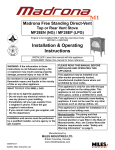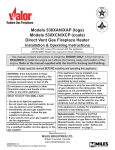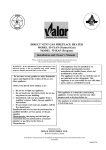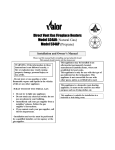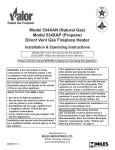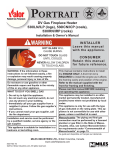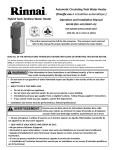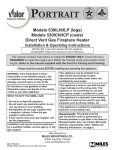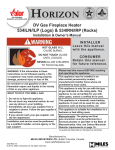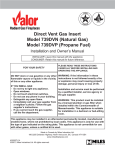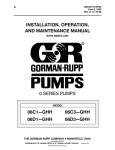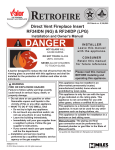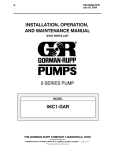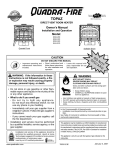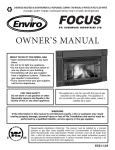Download Valor Fires 541 Owner`s manual
Transcript
Model 530XAN/XAP Model 530XCN/XCP Direct Vent Gas Fireplace Heater (With Logs or Coals) Installation and Owner’s Manual Please read this manual before installing and operating this heater This manual should remain with the homeowner WARNING: If the information in these instructions is not followed exactly, a fire or explosion may result causing property damage, personal injury or loss of life. - Do not store or use gasoline or other flammable vapors and liquids in the vicinity of this or any other appliance. -WHAT TO DO IF YOU SMELL GAS • Do not try to light any appliance. • Do not touch any electrical switch: do not use any phone in your building. • Immediately call your gas supplier from a neighbor’s phone. Follow the gas supplier’s instructions. • If you cannot reach your gas supplier, call the fire department. - Installation and service must be performed by a qualified installer, service agency or the gas supplier. This appliance may be installed in an aftermarket permanently located, manufactured (mobile) home, where not prohibited by local codes. This appliance is only for use with the type of gas indicated on the rating plate. This appliance is not convertible for use with other gases, unless a certified kit is used. This appliance is a domestic room-heating appliance. It must not be used for any other purpose such as drying clothes etc. B-Vent Installations If this appliance is intended to be installed with a B-Vent instead of direct vent, discard this manual. Follow the installation and operating procedure in the manual supplied with the B-Vent adapter kit #552BVK. This appliance is suitable for installation in a bedroom or bed sitting room. Massachusetts: the piping and the final gas connection must be performed by a licensed plumber or gas fitter in the State of Massachusetts Manufactured by MILES INDUSTRIES LTD. British Columbia, Canada Vous pouvez vous procurer un exemplaire en langue Française de cette brochure chez votre marchand. 4000305/04 CONTENTS 1. 2. SAFETY INFORMATION..................................................................................................................................................................... 3 OPTIONS .................................................................................................................................................................................................. 4 2.1 Appliance styles................................................................................................................................................................................ 4 2.2 Additional optional features ......................................................................................................................................................... 4 2.3 LP Gas ................................................................................................................................................................................................ 4 2.4 Venting options ................................................................................................................................................................................ 4 3. GENERAL.................................................................................................................................................................................................. 7 3.1 Approvals & codes ........................................................................................................................................................................... 7 3.2 Ratings................................................................................................................................................................................................ 7 3.3 Wall Thickness ................................................................................................................................................................................ 7 3.4 Supply Gas 7 3.5 Controls ............................................................................................................................................................................................. 7 3.6 Electrical............................................................................................................................................................................................ 7 4. LOCATION – PRESIDENT FS............................................................................................................................................................ 8 4.1 Wall & Floor Fixing ......................................................................................................................................................................... 8 4.2 Venting configurations................................................................................................................................................................... 8 5. LOCATION – ZERO CLEARANCE ................................................................................................................................................ 15 5.1 Framing General............................................................................................................................................................................ 15 5.2 Finishing General............................................................................................................................................................................. 15 5.3 President 536/ Bolero 541 Fronts 15 5.4 Windsor Arch 539 Front 16 5.5 Z.C Venting Configurations ....................................................................................................................................................... 17 6. RECESSED INSERT APPLICATIONS ........................................................................................................................................... 23 7. DIRECT VENT TERMINAL LOCATION .......................................................................................................................................... 24 8. HEATER PACK CONTENTS 25 9. HEATER PREPARTION..................................................................................................................................................................... 26 9.1 Detach the window ....................................................................................................................................................................... 26 9.2 Check ignition spark..................................................................................................................................................................... 26 9.3 Burner Module Removal ............................................................................................................................................................. 26 9.4 Conversion to Top Outlet ........................................................................................................................................................... 27 9.5 Rear Outlet Preparation .............................................................................................................................................................. 28 9.6 DuraVent Co-Linear..................................................................................................................................................................... 28 9.7 Valor 556 CLA Co-Linear Adapter ............................................................................................................................................ 28 9.8 Air Restrictor .................................................................................................................................................................................. 29 10. INSTALLING HORIZONTAL TERMINATION. ....................................................................................................................... 30 11. INSTALLING ROOF TERMINATION.......................................................................................................................................... 32 12. REMOTE CONTROL INSTALLATION ....................................................................................................................................... 33 13. GAS SUPPLY INSTALLATION ....................................................................................................................................................... 34 14. AERATION SETTING CHECK ....................................................................................................................................................... 35 15. CERAMIC FUEL BED INSTALLATION....................................................................................................................................... 35 15.1 Ceramic Walls Installation .......................................................................................................................................................... 35 15.2 Ceramic Log Installation ............................................................................................................................................................. 36 15.3 Ceramic Coals Installation.......................................................................................................................................................... 37 16. WINDOW REFITTING & CHECKING.......................................................................................................................................... 38 17. OPERATION CHECKS....................................................................................................................................................................... 38 18. INSTALLATION OF FRONTS AND COMPONENTS 39 18.1 President 531 Free Standing Front 39 18.2 President 536/Bolero 541 Z.C Fronts 40 18.3 Windsor Arch 539/549 Fronts.......................................................................................................................................................... 42 19. OWNERS INFORMATION................................................................................................................................................................ 44 19.1 Operating Your Fire 19.2 Operating remote control ........................................................................................................................................................... 44 19.3 Cleaning........................................................................................................................................................................................... 45 19.4 Checks .............................................................................................................................................................................................. 47 19.5 Servicing .......................................................................................................................................................................................... 47 19.6 General servicing 20. WARRANTY............................................................................................................................................................................................ 48 2 of 48 1.0 SAFETY INFORMATION WARNING: Do not operate the appliance with the glass front removed, cracked or broken. Replacement of the glass should be done by a licensed or qualified service person. (The whole window unit may be temporarily removed by the owner for cleaning the interior of the firebox, etc.) Only the authorized Valor replacement window unit listed in the repair parts booklet must be fitted - never use substitutes. If the glass is damaged search inside and adjacent to the appliance for any glass fragments. Due to high temperatures, the appliance should be located out of traffic and away from furniture and draperies. Children and adults should be alerted to the hazards of high surface temperatures and should stay away to avoid burns or clothing ignition. Young children should be carefully supervised when they are in the same room as the appliance. Clothing or other flammable material should not be placed on or near the appliance. This appliance must be installed and repaired by a qualified service person. The appliance should be inspected before use and at least annually by a professional service person. More frequent cleaning may be required due to excessive lint from carpeting, bedding material, etc. It is imperative that control compartments; burners and circulating air passageways of the appliance are kept clean. Keep curtains, clothing, furniture and other flammable materials a safe distance from all parts of the appliance and its vent system. Keep the appliance area well clear and free from combustible materials, gasoline and other flammable vapors and liquids. Never attempt to burn paper or any other material in the appliance. The venting terminal must not be recessed into a wall or siding. The vent terminal on the outside wall must be kept free from obstructions. No objects should be placed within 2 feet (60cm) of the vent terminal. The terminal is hot during operation and requires a guard if it is accessible to any person. An approved Valor guard is available from your dealer. During extreme weather conditions ensure that the vent outlet is free from ice and snow before attempting to light. Do not use this appliance if any part has been under water. Immediately call a qualified service technician to inspect the appliance and to replace any part of the control system and any gas control, which has been under water. NOTE When operating your new fireplace for the first time, some vapors may be released due to the burning of curing compounds used in the manufacture of the appliance. They may cause a slight odor and could cause the flames to be the full height of the firebox, or even slightly higher, for the first few hours of operation. It is also possible that these vapors could set off any smoke detection alarms in the immediate vicinity. These vapors are quite normal on new appliances and are totally harmless. After a few hours use the vapors will have disappeared and the flames will be at their normal height. During the first hour of use the ceramic firebox walls may go a smoky color. This is not soot. It is a temporary effect lasting only while the ceramic material becomes stabilized. The walls will revert to their initial color after your fire has been used for one or two hours. 3 of 48 2.0 OPTIONS 984 Heater engine unit # 530 X is available in either natural gas or LPG and comes equipped with either a simulated log or coal fuel bed in either fuel. The 530X engine unit is supplied standard with a rear vent D.V outlet and may be converted to a top outlet D.V with no extra parts required. The engine is not supplied suitable for zero clearance, the parts required to make the engine zero clearance are supplied with the various front trims (except 549 front) 942 945B 990B 908B 907B 906B 904B 903B 902B 911B 2.1 Appliance styles President FS 531 Free standing cast iron stove. (See figure 1). President 536 For recessed application, either zero clearance or insert . (See figure 2) Windsor Arch 539/549 Arched Cast Iron Front for recessed application, either zero clearance(see fig 3) or insert (see fig 4). (549 version is insert only ) Bolero 541 Contemporary cast iron front for recessed application, either zero clearance or insert (see fig 5). One of the above kits must be used with each installation. 981 982 980 991 940 941 963 943 2.2 Additional optional features Circulating Fan Kit #555CFK Having variable speed and temperature control, it is designed to boost the natural convection process through the appliance. It may be fitted before the fireplace is installed or retrofitted at a later date. Closure Plate #3336 CP 33” high x 36” wide black closure plate with black aluminum extrusion edge. To cover openings for insert applications. 943S 953 988 923GCL 923GK 984 2280 2.3 LP Gas LPG Conversion kit Burner & injector kit for conversion from natural gas to propane – Kit #554LPK. 835TG 2.4.2 2.4 Venting options Direct Vent Co-Linear Installations – for Free Standing or Recessed Installations (flexible piping) Converts the appliance outlet collars to accept two 3” dia. Flex liners for installation into existing solid fuel burning fireplaces and chimneys. Requires 556 CLA adapter and 923 GK termination kit along with either a 980 or 991 termination cap.( 923GCL may be used in lieu of 556 CLA adapter) 2.4.1 Direct vent installations (solid piping) One or more of the accessories listed below must be used for each installation. See the “Location” section of this manual. Kit# 551DVK Valor Horizontal terminal kit with pipe section. Maximum useable length 26”. (66cm) (Maximum 14” thru combustible wall section (36cm) 556 CLA Co-Linear appliance Adapter 558FLK Through the wall Dura-vent pipe insulation kit 817VAK Adapter for Dura-vent pipes Dura-vent DV GS horizontal square terminal cap Dura-vent DV GS wall thimble kit 45° Dura-vent DV GS elbow 90° Dura-vent DV GS elbow 6” Dura-vent DV GS pipe length 9” Dura-vent DV GS pipe length 12” Dura-vent DV GS pipe length 24” Dura-vent DV GS pipe length 36” Dura-vent DV GS pipe length 48” Dura-vent DV GS pipe length Adjustable 11”-145/8” Dura-vent DV GS pipe length Dura-vent DV GS snorkel termination unit – 36” rise Dura-vent DV GS snorkel termination unit – 14” rise Dura-vent DV GS Low Profile vertical termination cap Dura-vent DV GS high wind vertical termination cap Dura-vent DV GS round ceiling support Dura-vent DV GS cathedral ceiling support box Dura-vent DV GS ceiling firestop Dura-vent DV GS adjustable roof flashing. Roof pitch 0/12 – 6/12 Dura-vent DV GS steep roof flashing. Roof pitch 7/12 – 12/12 Dura-vent DV GS storm collar Dura-vent DV GS wall strap Dura-vent DV GS co-axial to co-linear appliance connector Dura-vent DV GS co-linear termination kit Dura-vent DV GS square terminal cap Dura-vent DV GS co-linear flex chimney liner 35ft. length. Terminal Guard 2.4.3 B-vent installations – For President Free Standing only Kit #552BVX converts this appliance from a direct vent fireplace heater to a gravity vent fireplace heater for use with a 4” “B” type vent. A full installation and operating manual is supplied with the kit. 4 of 48 Mantle depth “A” Up to 12” Above 12” up to 18” More than 18” Figure 1. Model 531 President Free Standing – Dimensions Mantle leg projection “D” Up to 8” More than 8” Min clearance from appliance side “E” 1” 6” Mantle depth “A” Up to 7” Above 7” up to 8” Above 8” up to 9” Above 9” up to10” Above 10” up to 12” More than 12” Min. Clearance“B” 4” 5” 7” 8” 9” 9”+extra 1” for every 1” depth above 12” Min clearance from appliance side “E” 0” 6” Mantle leg projection “D” Up to 8” More than 8” Figure 2. Model 536 Recessed President – Dimensions Figure 3. Model 539 Windsor Arch. with Backplate - Dimensions 5 of 48 Min. Clearance“B” 4” 8” 8”+extra 1” for every 1” depth above 18” Fig 4. 549 Windsor Arch without backplate. Note – this option is intended for insert applications only and does not include the stand-offs and insulation pads required for zero clearance applications. Most recessed 530 insert applications will also require a 556 CLA co-linear adapter Fig 5. - 541 Recessed Bolero Dimensions 6 of 48 3.0 GENERAL 3.1 Approvals & codes This appliance is certified by International Approval Services for use in Canada and the USA. The appliance complies with CGA P.4.1, Testing method for measuring annual fireplace efficiencies. The installation must conform with local codes or, in the absence of local codes with the National Fuel Gas Code, ANSI Z223.1or the Canadian installation code CAN/CGA-149. Only qualified licensed or trained personnel should install the appliance. The appliance, when installed, must be electrically grounded in accordance with local codes or, in the absence of local codes, with the National Electrical Code, ANSI/NFPA 70 or the Canadian Electrical Code, CSA C22.1. 3.2 Ratings Nat. Gas LPG Altitude (Ft) 0-4500 * Input Max. (Btu/h) 20,500 19,000 Input Min (Btu/h) 6,000 11,600 Manifold pressure (in.w.c.) 3.5 – 3.9 10.3 – 10.7 Min. Supply pressure (in. w.c.) 5.0 11.0 Max. Supply pressure (in. w.c.) 10.5 14.0 *Tested to CAN/CGA - 2.17 Gas fired appliances for use at high altitudes. In the USA installations may require deration over 2000ft - Check local codes. 3.3 Wall Thickness The appliance vent is suitable for penetrating a combustible wall up to 14” (36cm) thick. A non-combustible wall can be any thickness up to the maximum horizontal run of vent pipe allowed for the particular installation – See sections 4 and 5. 3.4 Supply Gas Heater engine 530XAN /XCN is used on Natural gas installations. Heater engine 530XAP/XCP is used on Propane installations. The supply pressure must be between the limits shown in section 3.2 above. The supply connection is 3/8’’NPT. The opening for the gas supply line is at the rear left corner of the appliance. 3.5 Controls The unit is supplied standard with a battery operated, hand held remote control and receiver which has the ability to adjust the gas input of the unit between the pilot setting and the maximum input .The pilot light must be manually lit at the valve and may be left on or turned off with each use. The remote control provides full thermostatic or manual operation with the option of programming thermostat function between certain times of the day. Manual operation of the valve is also possible should the batteries or remote control fail. 3.6 Electrical The unit does not require an electrical power source unless fitted with an optional circulating fan. 7 of 48 4.0 LOCATION – PRESIDENT FREE STANDING 4.1 Wall & Floor Fixing The President FS can be installed against a wall or in the room away from walls. The appliance is designed to be fixed to the floor. The appliance can additionally or alternatively be fixed to a rear wall. The fixing positions are shown in figure 6. The appliance is approved for installation directly on wood flooring. If the appliance is installed directly on carpeting, vinyl tile or other combustible material other than wood flooring, it must be installed on a metal or wood panel extending the full width and depth of the appliance. Figure 6 President FS fixing holes 4.2 Venting configurations 4.2.1 Flat on wall Requires Valor vent kit #551DVK or Dura-vent pipe length with adapter #817VAK and Dura-vent terminal cap. The location requirements are shown in figure 7. The horizontal vent run cannot be extended beyond the dimensions shown in figure 5 by the use of any vent accessory pipes. Figure 7 4.2.2 Flat on wall with snorkel termination (Fig.8) For use on horizontal vent installations where the outside ground level is too close to the standard terminal. Adapter #817VAK, a Dura-vent pipe length and snorkel termination #981 or #982 will be required (See vent options section of this manual). 4.2.3 Figure 8 8 of 48 Rear vent connection, vertical vent rise with horizontal termination (Fig. 9) Can be used with either #551DVK standard vent kit or #984 Dura-vent terminal cap and accessories. Adapter #817VAK, two 90° vent elbows #990B and Dura-vent pipe lengths will be required. (See venting options section of this manual). No more than two 90°elbows must be used. A: From floor to top of vent duct B: Back of appliance to outside wall C: Back of appliance to inside wall D: Vertical pipe run E: Horizontal pipe run (Total before and after elbows) F: Clearance to combustible materials above horizontal pipe run G: Clearance to combustible materials below horizontal pipe run H: Clearance to combustible materials all round vertical pipe run and at sides of horizontal pipe run Minimum 3ft 7in (109cm) 141/8in (36cm) 12in (30cm) - Maximum 10ft 7in (323cm) 5ft 5in (165cm) 8ft (244cm) 4ft 6in (137cm) 25/8in (6.7cm) - 15/16in (3.3cm) - 15/16in (3.3cm) - Figure 9 4.2.4 Rear vent connection, vertical vent rise with horizontal snorkel termination 4.2.5 Corner location, horizontal vent run only (Fig. 10) For “semi-basement” situations where vertical vent rise does not raise horizontal termination sufficiently above ground level. The dimensional requirements in section 4.2.3 and figure 9 apply. Adapter #817VAK, two 90° vent elbows #990B, Dura-vent pipe lengths and a Dura-vent snorkel termination will be required. #942 Dura-vent wall thimble kit may also be necessary. (See venting options section of this manual). No more than two 90°elbows must be used. Can be used with either #551DVK standard vent kit or #984 Dura-vent terminal cap and accessories. Adapter #817VAK and 45° Dura-vent elbow will be required. (See venting options section of this manual). Be aware of the limited maximum vent pipe length and wall depth for this type of installation – See figure 10. Figure 10 9 of 48 4.2.6 Corner location, rear vent connection, vertical rise, horizontal termination (Figs 9 & 11) Can be used with either #551DVK standard vent kit or #984 Dura-vent terminal cap and accessories. Adapter #817VAK, two 90° vent elbows #990B and Dura-vent pipe lengths will be required. (See venting options section of this manual). No more than two 90°elbows must be used. All vertical dimensional limits are as section 4.2.3. Figure 11 4.2.7 Rear vent connection, vertical vent rise with through the roof termination (Fig.12) Adapter #817VAK, one 90° vent elbow #990B, Dura-vent pipe lengths, a vertical vent terminal and roof flashing will be required. Various other ceiling or roof items may be necessary depending on the particular installation (See venting options section of this manual). Figure 12 4.2.8 4.2.9 Rear vent connection, vertical vent rise with offset and through the roof termination (Fig.13) For situations where offset is necessary in an attic to avoid obstructions or allow useful space. Adapter #817VAK, one 90° vent elbow#990B, two 45° vent elbows #984, wall straps, a vertical vent terminal, roof flashing and Dura-vent pipe lengths will be required. Various other ceiling or roof items may be necessary depending on the particular installation (See venting options section of this manual). Figure 13 10 of 48 Rear vent connection, installed to fireplace chimney with co-linear liners (Fig.14) Only for use when retrofitting a noncombustible fireplace and chimney. The appliance must not be connected to a chimney flue serving a separate solidfuel burning appliance. Requires 556 CLA Co-Axial to CoLinear appliance adapter, two lengths of 3” dia. Flexible Chimney liner , colinear termination kit and flashing #923GK and either high wind vertical vent terminal cap #991 or a 980 Low Profile vertical termination cap .(See vent options section of this manual). Figure 14 4.2.10 Rear Vent Conversion to BVent using 552 BVK Adapter Free Standing Only ( Fig 15) Used to field convert heater from direct vent to 4” dia. gravity vent on free standing units only . A full installation and operating manual is supplied with the kit. 4.2.11 552 BVK Adapter Fig 15. 11 of 48 Top vent connection, vertical vent rise with horizontal rear termination (Fig.16) Can be used with either #551DVK standard vent kit or #984 Dura-vent terminal cap and accessories. Adapter #817VAK, one 90° vent elbow #990B and Dura-vent pipe lengths will be required. (See venting options section of this manual). No more than two 90°elbows must be used. A: From floor to top of vent duct B: Back of appliance to inside wall C: Vertical pipe run D: Horizontal pipe run E: Clearance to combustible materials above horizontal pipe run F: Clearance to combustible materials below horizontal pipe run G: Clearance to combustible materials all round vertical pipe run and at sides of horizontal pipe run Minimum 4ft (122cm) 31/4 in (79mm) 9in (23cm) 25/8in (6.7cm) Maximum 11ft (335cm) 8ft (244cm) 4ft 6in (137cm) - 15/16in (3.3cm) - 15/16in (3.3cm) - Figure 16 4.2.12 Top vent connection, vertical vent rise with horizontal side termination (Figs.16 &17) Can be used with either #551DVK standard vent kit or #984 Dura-vent terminal cap and accessories. Adapter #817VAK, one 90° vent elbow #990B and Dura-vent pipe lengths will be required. (See venting options section of this manual). No more than two 90°elbows must be used. All vertical dimension, pipe run and clearance limits are as section 4.2.11. 4.2.13 Top vent connection, vertical vent rise with horizontal side Figure 17 or rear snorkel termination The dimensional requirements in sections 4.2.11 and 4.2.12 apply. Adapter #817VAK, one 90° vent elbow #990B, Dura-vent pipe lengths and a Dura-vent snorkel termination will be required. #942 Dura-vent thimble kit may also be necessary. (See venting section of this manual). 12 of 48 4.2.14 Top vent connection, corner location, vertical rise, horizontal termination, 45° pipe bend (Figs 16 & 18) Can be used with either #551DVK standard vent kit or #984 Dura-vent terminal cap and accessories. Adapter #817VAK, one 90° elbow #990B, one 45° elbow #945B and Dura-vent pipe lengths will be required. (See venting section of this manual). All vertical dimensions and clearance limits are as section 4.2.11. Figure 18 4.2.15 Top vent connection, corner location, vertical rise, straight horizontal termination (Figs 16 & 19) Can be used with either #551DVK standard vent kit or #984 Dura-vent terminal cap and accessories. Adapter #817VAK, one 90° elbow #990B and Dura-vent pipe lengths will be required. (See venting section of this manual). All vertical dimensions and clearance limits are as section 4.2.11. . Figure 19 4.2.16 Top vent connection, vertical vent rise, through the roof termination (Fig. 20) Adapter #817VAK, Dura-vent pipe lengths, a vertical vent terminal and roof flashing will be required. Various other ceiling or roof items may be necessary depending on the particular installation (See venting options section of this manual). Figure 20 13 of 48 4.2.17 Top vent connection, vertical vent rise with offset and through the roof termination (Fig.21) For situations where offset is necessary in an attic to avoid obstructions or allow useful space. Adapter #817VAK, two 45° vent elbows #984, wall straps, a vertical vent terminal, roof flashing and Dura-vent pipe lengths will be required. Various other ceiling or roof items may be necessary depending on the particular installation (See venting options section of this manual). Figure 21 14 of 48 5.0 LOCATION –ZERO CLEARANCE 5.1 Framing -General The framing dimensions vary with the different cast iron fronts and with different vent configurations, allowing for elbows etc. Read framing drawings carefully. 5.2 Finishing- General The President 536 and Bolero 541 Fronts come supplied with a Framing Plate for zero clearance applications. The Framing Plate is painted black and may be left exposed beyond the perimeter of the of the cast iron front or may be covered with non-combustible material if desirable ( see figs 24 &25 ). Windsor Arch 539 Front comes with an integral back plate ( see fig 3) • A non-combustible hearth is not necessary in front of this appliance. • The appliance is approved to install directly on wood sub- flooring • Any framing construction must be clear of standoffs (See figures 1-4 ). • Be aware of the area 71/2” x 26¼” (19cm x 67cm) immediately above the Framing Plate used with the 536/541 Cast Fronts must be constructed with non-combustible materials as shown in figures ( 22 &23 ). 5.3 President 536/ Bolero 541 Fronts Fig 22, Rear Vent Framing, 536/541 Fronts Fig 24, Framing Plate Exposed, 536/541 Fronts Fig 23 , Top Vent Framing, 536/541 Fronts. Fig 25, Framing Plate covered, 536/541 Fronts 15 of 48 5.4 Windsor Arch 539 Front – Zero Clearance ( Note – 549 version of the Windsor Arch Front (without the backplate) does not come with zero clearance items and is intended for insert applications only) Combustible wall finish may be used behind the cast iron plate up to the extent of the framed opening shown in fig 26. Fig 26, Framing 549 Front Fig 27, Combustible Overlay to Cast Iron Plate. 16 of 48 5.5 Z.C VENTING CONFIGURATIONS ( ALL FRONTS) 5.5.1 Flat on wall (Fig. 28) Requires standard vent kit #551DVK only. The horizontal vent run cannot be extended by the use of any vent accessory pipes. Figure 28 5.5.2 Flat on wall with snorkel termination (all fronts) (Fig. 29) For use on horizontal vent installations where the outside ground level is too close to the standard terminal. Adapter #817VAK, a Dura-vent pipe length and snorkel termination #981 or #982 will be required (See vent options section of this manual). Figure 29 17 of 48 5.5.3 Rear vent connection, vertical vent rise with horizontal termination (all fronts)(Fig. 30) Can be used with either #551DVK standard vent kit or #984 Dura-vent terminal cap and accessories. Adapter #817VAK, two 90° vent elbows #990B and Duravent pipe lengths will be required. (See venting options section of this manual). No more than two 90°elbows must be used. A: From floor to top of vent duct D: Vertical pipe run E: Horizontal pipe run (Total before and after elbows) F: Clearance to combustible materials above horizontal pipe run G: Clearance to combustible materials below horizontal pipe run H: Clearance to combustible materials all round vertical pipe run and at sides of horizontal pipe run 5.5.4 Minimum 3ft 77/8” (111cm) 12in (30cm) - Maximum 10ft 77/8” (325cm) 8ft (244cm) 4ft 6in (137cm) 25/8” (6.7cm) - 15/16” (3.3cm) Figure 30 15/16” (3.3cm) - Rear vent connection, vertical vent rise with horizontal snorkel termination ( all fronts) For “semi-basement” situations where snorkel accessory alone does not raise termination sufficiently above ground level. The dimensional requirements in section 5.5.3 and figure 30 apply. Adapter #817VAK, two 90° vent elbows #990B, Dura-vent pipe lengths and a Dura-vent snorkel termination will be required. #942 Dura-vent wall thimble kit may also be necessary. (See venting options section of this manual). No more than two 90°elbows must be used. 5.5.5 Corner location, horizontal vent run only, (all fronts) (Fig. 31) Can be used with either #551DVK standard vent kit or #984 Dura-vent terminal cap and accessories. Adapter #817VAK and 45° Dura-vent Figure 31 elbow will be required. (See venting options section of this manual). 18 of 48 5.5.6 Corner location, rear vent connection, vertical rise, horizontal termination (all fronts) (Figs 30 & 32) Can be used with either #551DVK standard vent kit or #984 Dura-vent terminal cap and accessories. Adapter #817VAK, two 90° vent elbows #990B and Dura-vent pipe lengths will be required. (See venting options section of this manual). No more than two 90°elbows must be used. All vertical dimensional limits are as section 5.5.3 Figure 32 5.5.7 Rear vent connection, vertical vent rise with through the roof termination, (all fronts) (Fig.33) Adapter #817VAK, one 90° vent elbow #990B, Dura-vent pipe lengths, a vertical vent terminal and roof flashing will be required. Various other ceiling or roof items may be necessary depending on the particular installation (See venting options section of this manual). Figure 33 5.5.8 Rear vent connection, vertical vent rise with offset and through the roof termination (all fronts) (Fig.34) For situations where offset is necessary in an attic to avoid obstructions or allow useful space. Adapter #817VAK, one 90° vent elbow#990B, two 45° vent elbows #984, wall straps, a vertical vent terminal, roof flashing and Dura-vent pipe lengths will be required. Various other ceiling or roof items may be necessary depending on the particular installation (See venting options section of this manual). Figure 34 19 of 48 5.5.9 Top vent connection, vertical vent rise with horizontal rear termination(all fronts)(Fig.35) Can be used with either #551DVK standard vent kit or #984 Dura-vent terminal cap and accessories. Adapter #817VAK, two 45° elbows #945B, one 90° vent elbow #990B and Dura-vent pipe lengths will be required. (See venting options section of this manual). A: From floor to top of vent duct D: Vertical pipe run E: Horizontal pipe run F: Clearance to combustible materials above horizontal pipe run G: Clearance to combustible materials below horizontal pipe run H: Clearance to combustible materials all round vertical pipe run and at sides of horizontal pipe run Minimum 4ft 11/2” (126cm) 0” - Maximum 12ft 11/2” (370cm) 8ft (244cm) 4ft 6” (137cm) 25/8” (6.7cm) - 15/16” (3.3cm) Figure 35 15/16” (3.3cm) - 5.5.10 Top vent connection, vertical vent rise with horizontal side termination (all fronts)(Figs.35 &36) Can be used with either #551DVK standard vent kit or #984 Dura-vent terminal cap and accessories. Adapter #817VAK, two 45° elbows #945B, one 90° vent elbow #990B and Dura-vent pipe lengths will be required. (See venting options section of this manual). All vertical dimensions and clearance limits are as section 5.5.9. 5.5.11 Top vent connection, vertical vent rise with horizontal side or rear snorkel termination (all fronts) Figure 36 The dimensional requirements in sections 5.5.9 and 5.5.10 apply. Adapter #817VAK, two 45° elbows #945B, one 90° vent elbow #990B and Dura-vent pipe lengths will be required. #942 Dura-vent thimble kit may also be necessary. (See venting section of this manual). 20 of 48 5.5.12 Top vent connection, corner location, vertical rise, horizontal termination, 45° pipe bend (all fronts) (Figs 35 & 37) Can be used with either #551DVK standard vent kit or #984 Dura-vent terminal cap and accessories. Adapter #817VAK, two 45° elbows #945B, one 90° vent elbow #990B and Dura-vent pipe lengths will be required. (See venting section of this manual). All vertical dimensions and clearance limits are as section 5.5.9. Figure 37 5.5.13 Top vent connection, vertical vent rise, through the roof termination (all fronts)(Fig. 38) Adapter #817VAK, two 45° elbows #945B, Dura-vent pipe lengths, a vertical vent terminal and roof flashing will be required. Various other ceiling or roof items may be necessary depending on the particular installation (See venting options section of this manual). Figure 38 21 of 48 5.5.14 Top vent connection, vertical vent rise with offset and through the roof termination (all fronts)(Fig.39) For situations where offset is necessary in an attic to avoid obstructions or allow useful space. Adapter #817VAK, four 45° vent elbows #984, wall straps, a vertical vent terminal, roof flashing and Dura-vent pipe lengths will be required. Various other ceiling or roof items may be necessary depending on the particular installation (See venting options section of this manual). Figure 39 22 of 48 6.0 Recessed Insert Applications Rear or Top Outlet Conversion to co-linear liners using 556 CLA Co-Linear Adapter. ( all fronts ) ( Simpson DuraVent 923 GCL may also be used as an alternate to the 556 CLA) Only for use when retrofitting a non-combustible fireplace and chimney. The appliance must not be connected to a chimney flue serving a separate solid-fuel burning appliance. Requires 556 CLA Co-Axial to Co-Linear appliance adapter ( or alternatively, a 923 GCL), two lengths of 3” dia. Flexible Chimney liner , co-linear termination kit and flashing #923GK and either high wind vertical vent terminal cap #991 or a 980 Low Profile vertical termination cap . Zero Clearance stand-offs and insulation pads, supplied with the various fronts are not required for this application. A model 3336 Closure Plate is available to cover fireplace openings. Co-Linear Installation into Existing F/P 556 CLA Kit Components 923 GCL Adapter ( alternate to 556 CLA) 3336 CP Closure Plate ( 536 & 541 Fronts) 556 CLA Rear Mounted 991 High Wind Cap 556CLA Top Mounted 980 Low Profile Cap 23 of 48 923 GK Termination 7.0 Direct Vent location • The vent terminal must be located on an outside wall or through the roof. • This direct vent appliance is designed to operate when an undisturbed airflow hits the outside vent terminal from any direction. • The minimum clearances from this terminal that must be maintained when located on an outside wall are shown in figure 40. Any reduction in these clearances could result in a disruption of the airflow or a safety hazard. Local codes or regulations may require greater clearances. • The vent terminal must not be recessed into a wall or siding. • The vent terminal should be positioned where any snowdrifts will not cover it. Fig. 40 Vent terminal locations KEY A B C D E F G H I J K L M Note: VENT TERMINAL LOCATIONS - MINIMUM DISTANCES See figure 34 Clearance above grade, verandah, porch, deck or balcony Clearance to window or door that may be opened Clearance to permanently closed window (recommended to prevent condensation on window) Vertical clearance to ventilated soffit located above the terminal within a horizontal distance of 2 feet (60 cm) from the center-line of the terminal Clearance to unventilated soffit Clearance to outside corner Clearance to inside corner Horizontal clearance to center-line of meter/regulator assembly located below the terminal Clearance to service regulator vent outlet Clearance to non-mechanical air supply inlet to the building or the combustion air inlet to any other appliance Clearance to a mechanical air supply inlet Clearance above paved sidewalk or a paved driveway located on public property. Note: A vent must not terminate directly above a sidewalk or paved driveway, which is located between two single-family dwellings and serves both dwellings. Clearance under a verandah, porch, deck or balcony Only permitted if veranda, porch, deck or balcony is fully open on a minimum of 2 sides beneath the floor. Local codes and regulations may require different clearances. 24 of 48 MINIMUM CLEARANCE Ins Cms 12 30 12 30 12 30 18 46 12 12 12 36 30 30 30 90 72 12 180 30 72 84 180 210 12 30 8.0 PACK CONTENTS( Heater/Engine & Accessories) #530 Engine unit (Either log or coal version supplied) 1 Appliance engine unit fitted with window 2 Restrictor plates type #1 for log versions 2 Restrictor plates type #2 for log versions 2 Restrictor plates type #3 for log versions 2 Restrictor plates type #4 for coal versions 2 Restrictor plates type #5 for coal versions 2 Restrictor plates type #6 for coal versions 1 Port cover 1 Gas inlet pipe connection adapter 1 Firebox ceramic rear wall 2 Firebox ceramic sidewalls 5 Ceramic fuel effects (logs or coals) 4 Wood screws 4 Wall plugs 2 Thread cutting screws 1 Deluxe remote control kit incl. receiver and handset #551DVK Standard horizontal through the wall vent kit (Alternative to Dura-vent unit) 1 Vent pipe & terminal unit 2 Wall plates 2 Wall shields (Supplied flat) 12 Thread cutting screws 1 Styrofoam cutting support do-nut 8 Wood screws 8 Wall plugs #552 BVK B-vent adapter kit 1 Rear mounted, 4” dia top discharge draft hood 1 Restrictor plate 1 Vent safety switch & interrupter block #555CFK Circulating fan kit (Additional option) Details are with the kit #556 CLA Co-Linear Adapter 1 4” dia replacement exhaust spigot 1 4” dia. Fiber gasket 1 Replacement outer vent plate with two 3” dia collars. Take care when removing the contents from the packaging to prevent damage. Check that all the contents are in the packs and are undamaged. 25 of 48 9.0 APPLIANCE PREPARATION( Heater/Engine ) 9.1 Detach the window 1. Release the top of the window by pulling forward and rotating outwards the two bars at the top corners. See figure 41. 2. Unscrew the two spring loaded bolts securing the bottom of the window. See figure 41. 3. Carefully lift the window. Keep the window and bolts in a safe place. 4. Remove ceramic Bricks/Logs/Coals from Firebox. 9.2 Check ignition spark The pilot burner and electrode unit is at the left end of the burner. Push in the lighting knob and turn counter-clockwise through the “IGN” position to “PILOT”. A spark should flash across from the pilot electrode to the pilot burner shield. See figure 42. Figure 41 Figure 42 9.3 Burner Module Removal It may be desirable to remove the burner module to gain access for gas fitting, to install a fan kit, or to fasten the unit to the floor of plinth supplied with the zero clearance fronts. See fig 43. Figure 43 26 of 48 9.4 Conversion to Top Outlet For Solid Direct Vent Piping If installing with rear vent outlet go to next step. 1. Remove the top plate and seal by unscrewing 12 screws. (See figure 44). Keep the seal, plate and screws for fitting to the back. 2. Remove the rear outer vent collar and seal by unscrewing 12 screws (See figure 44). 3. Remove the rear inner vent collar and seal by unscrewing 8 screws. (See figure 44). 4. To make sure that the collars are axially aligned, fit the Dura-vent adapter #817VAK over the outer vent collar. See figure 45. 5. Position the inner collar and seal vertically inside the top of the appliance. Drop the outer collar with adapter over the inner collar to ensure alignment. Secure the inner collar with 8 screws and the outer collar with 12 screws. See figure 45. 6. Fit the plate and seal (which was previously removed from the top) to the back of the appliance with 12 screws. See figure 44. Figure 44 Figure 45 27 of 48 9.5 Rear Vent Outlet Preparation For Installations Using Dura-Vent DV GS Pipes If installing straight off the back venting with Valor terminal kit #551DV only, ignore this step: 1. Fit the Dura-vent adapter #817VAK over the appliance vent collars pushing on firmly. Align the adapter so that the seam on horizontal Dura-vent pipes is not at the bottom – Check by temporarily fitting a Dura-vent pipe. 2. Drill through the adapter outer tube and appliance outer collar for #6 screws. See figure 46. Make sure that the drill does not penetrate the inner tubes. 3. Secure the adapter to the outer collar with two #6 thread cutting screws supplied (Fig. 46). Figure 46 9.6 For Installations With Dura-Vent DV GS Co-Linear Liners: 1. Fit the Dura-vent adapter #817VAK over the appliance vent collars pushing on firmly. 2. Fit and fully twist-lock the Dura-vent co-axial to co-linear connector #923GCL to the #817VAK adapter. 3. Keeping the connector and adapter fully twist-locked; rotate them so that the air inlet collar on the connector is at the bottom. See figure 47. 4. Drill through the adapter outer tube and appliance outer collar for #6 screws. See figure 46. Make sure that the drill does not penetrate the inner tubes. 5. Secure the adapter to the outer collar with two #6 thread cutting screws supplied (Fig. 46). Figure 47 9.7 For Installations with Valor 556 CLA Co-Linear adapter ( see fig. 48 ) ( Note – Instructions may vary as 556CLA may be installed on Top or Back of Heater.) 1. Remove blank plate and gasket to gain access to exhaust spigot. Retain plate and gasket for re-use later 2. Remove existing outer intake plate. Retain gasket only for re-use. 3. Remove existing exhaust spigot – gasket below should remain on heater. 4. Install new co-linear exhaust spigot re-using existing screws. Ensure all screws are reinstalled tightly. 5. Install new co-linear outer plate ( note – up/down front/back orientation on drawing) re-using existing Figure 48 gasket and screws. Use 6 additional screws supplied to seal outer plate to gasketed flange of exhaust spigot. Connect 3” dia. flex liners directly to outer plate collars using sheet metal screws. Note - “exhaust” & “intake” must correspond with roof termination. 28 of 48 9.8 Attaching Air Restrictors – Appliances with Vertical Vent Rise Only No restrictors are required for appliances, which only have a horizontal vent, run. There are three types of restrictor supplied with each #530 engine unit. They are slightly different in size. They can be identified by the number printed on them. – See figure 49. The restrictors cover part of the openings in the firebox rear wall ports – See figure 50. Each restrictor can be fitted at either Maximum or minimum port opening – See figure 50. Types 1, 2 and 3 are supplied with ceramic log appliances. Types 4, 5, and 6 are supplied with ceramic coal appliances. The correct restrictors to be fitted for each type of installation are shown in the table below. To fit the restrictors, remove the center screws from the rear ports and fit the restrictors using these screws. To set the restrictors at maximum port opening, slacken the bottom screws in the ports, slide the restrictors down as far as possible and tighten the screws over the restrictors. To set the restrictors at minimum port opening, slide the restrictors up as far as possible and tighten the screws. With the largest restrictors, the upper screws may need to be slackened to allow the restrictors to go under the screw heads. Vent terminal Horizontal through wall (With vertical rise) Vertical through roof Vertical vent pipe run Less than 2ft (61cm) From 2ft (61cm) but less than 4ft (122cm) From 4ft (122cm) but less than 6ft (183cm) 6ft (183cm) or more Less than 13ft (396cm) 13ft (396cm) or more Use restrictor type Port opening Set at For Logs 1 For Coal 4 Maximum 1 4 Minimum 2 5 Maximum 2 5 Minimum 3 6 Maximum 3 6 Minimum Figure 50 29 of 48 Figure 49 10.0 INSTALLATIONS WITH HORIZONTAL TERMINATION – INSTALLING TO WALL See sections 4 & 5 for full range of horizontal termination applications. 10.1 Installations except with Valor #551DVK Terminal – Vent pipe fitting Fit all the required Dura-vent DV GS pipes and elbows securely twist locking each section. See the Dura-vent instructions supplied with the sections 10.2 Making Wall Opening If the wall is constructed of solid non-combustible materials and has no combustible surface cladding (including wood) inside or outside the wall plates or Dura-vent thimbles will not be required. With all the required Dura-vent pipes attached, slide the appliance into its correct location (If the Valor #551DVK terminal is being used, leave it off at this stage). If the wall has combustible material, mark the wall for a 10”x10” square hole if the wall. If the wall is totally non-combustible (e.g. masonry block or concrete) mark for a 7” circular hole. In both cases, the center of the hole should line up with the centerline of the horizontal vent. 10.3 Flat On Wall Installations With Valor #551DVK Terminal 1. Cut the vent terminal pipe unit to size (Fig. 51). Important! The drain hole must be clearly outside the wall. a) Measure the wall thickness. b) Add 11/4” (32mm) for wall stand-off spacers if fitted or, if appliance is not going to touch the wall, add distance from case rear to wall. c) Measure this total length along the vent unit from where the termination cap joins the main terminal pipes. Mark the unit. d) Insert the Styrofoam support ring and push it as close as possible to the marked position. e) Cut the vent tubes squarely to length. f) Make sure that all Styrofoam is removed from the vent unit after cutting. 2. Fit the vent unit fully over the appliance inlet and outlet collars pushing on firmly. Make sure that the drain hole is at the bottom – the seam will be through the notch in the wall plates – See figure 54. 3. Drill through the terminal outer tube and appliance outer collar for #6 screws. See figure 51. Make sure that the drill does not penetrate the inner tubes. 4. Secure the terminal to the outer collar with two #6 thread cutting screws supplied (Fig. 51). Figure 51 30 of 48 10.4 Preparing Wall Plates The wall plates are not used for 7” hole in non-combustible walls. 1. Bend the wall shields and screw to the inside of the wall plates with 6 thread cutting screws per plate. See figure 52. 2. Bend the inner wall plate tab as shown in figure 53 so that the seam on the terminal tube will pass clearly through the plate with the wall shield at the top. Place the inner wall plate over the terminal unit. Slide the appliance towards the wall so that the terminal enters the wall. Slide the inner wall plate up to the wall. Mark the four holes for the wall screws. Slide the plate away. 3. Drill and plug the wall. 4. Screw the plate to the wall with 4 screws provided. 10.4.1 Installing Appliance to Wall. 1. Slide the appliance fully up to the wall. 2. Bend the outer wall plate tab as shown in figure 53. Place the outer wall plate over the terminal unit. Slide the wall plate up to the wall. Mark the four holes for the wall screws. Slide the plate away. 3. Drill and plug the wall. 4. Screw the plate to the wall with 4 screws provided. See figure 54. 5. FS installations - Secure the appliance to the floor or wall if necessary. Figure 52 Figure 53 Figure 54 10.5 Installations except with Valor #551DVK Terminal – Installing to wall Unless the wall is totally non-combustible, fit Dura-vent wall thimbles #942. Slide the appliance into its correct position and install as detailed in the DuraVent instructions supplied with the pipes. FS installations - Secure the appliance to the floor or wall if necessary. Optional 835 Terminal Guard Valor 551 Terminal 31 of 48 11.0 INSTALLATIONS WITH THROUGH THE ROOF VERTICAL TERMINATION 11.1 All Co-axial Vent Installations 1. Check the roof pitch to determine which roof flashing will be needed - see vent accessories section 2.4. 2. The distance from the roof to the lowest terminal discharge opening (“H” in fig. 55) depends on the roof pitch and must be in accordance with the current CAN/CGA-B149 in Canada or ANSI Z223.1 in the USA. 3. The minimum clearances to combustible materials all round the vent pipes must be in accordance with the dimensions shown in sections 4 & 5 of this manual. 4. If rear vent connection to the appliance, fit a 90° Dura-vent DV GS elbow to the appliance vent adapter. 5. Place the appliance in its proper location. 6. Drop a plumb from the ceiling to the center of the appliance vent opening. Mark the position on the ceiling. Drill a small hole at the marked position. 7. Determine the position where the vent will pass through the roof. If directly above the position where it penetrates the ceiling, drop a plumb from the roof to the small hole in the ceiling and mark the roof at this spot. If rafters or other obstructions will prevent a vertical exit or if clear attic space is desired, the roof outlet can be offset using 45º elbows see fig. 55. Drill a small hole at the marked position. 8. A ceiling firestop must be installed at the second floor and higher floors. Fig 55 A ceiling support should be used below the flat ceiling. To install the firestop & support cut and frame a 10” (254mm) square hole centered on the small hole previously drilled - see fig. 56. 9. Fit vent accessory elbows and pipe lengths as required up through ceiling support boxes and firestops. If installation includes offset, support the offsetting pipes every 3 Fig 56 feet (1m) with wall straps (fig. 28). 10. Cut a hole in the roof centered on the small hole. The hole must allow for the minimum clearances to combustible materials - see sections 4 & 5. 11. Fit pipe lengths through the roof. Fit roof flashing securing it with roofing nails. 12. Fit storm collar and termination cap. 13. FS installations - Secure the appliance to the floor or wall if necessary. 11.2 Co-linear Vent Installations 1. The chimney and fireplace opening sizes are shown in section 2 of this manual. 2. Place the appliance (fitted with the co-linear near the fireplace opening but allow space for manipulating the chimney liners on to the appliance. 3. Drop the 3” dia. flexible liners into the chimney from outside. 4. Fit the liners to the co-linear adapter paying attention to inlet and exhaust and move the appliance to its proper position. Be aware of the minimum liner bend radius and maximum liner horizontal run shown in Section 6of this manual. 5. Fit the Dura-vent DV GS termination kit and flashing to the exterior of the chimney. 6. Secure the appliance to the floor or wall if necessary. 32 of 48 12.0 REMOTE CONTROL INSTALLATION Caution! Don’t connect the batteries to the remote control receiver until the wires are connected to the burner control unit, as short circuit could result in destruction of the electrical components. When installing the remote please refer to figures 57 and 58 below. • • • • • • Connect the wiring harness to the receiver box, by pushing the wire connector on to the receiver circuit board. The plug will only go on one way so please ensure that the wires are pointing up and slot in the board is inline with the tab on the wiring harness plug ( see fig 58 ) Connect wires as shown in Fig 58. Please note that the “L” connectors are different sizes, the smaller one fits to the lower connection on the valve.The other wire connectors can be fitted to either terminal . Remove the remote control receiver lid. Fit four 1.5V batteries. Place the remote control receiver on the “Velcro” pad. Fit the 9V battery to the handset transmitter Figure 57 Valve connections Remote control operating instructions are on page 44 of this manual and are supplied with the remote control kit. Figure 58 33 of 48 13.0 GAS SUPPLY INSTALLATION 1. The appliance is supplied for supply gas connection at the rear left corner of the case. Supply line connection to the inlet pipe of the appliance is 3/8”NPT ( female). Alternatively, the appliance inlet pipe may be removed and the supply line routed directly to the control unit having a 3/8” NPT female thread . Take care not to torque the valve or damage the wire connectors on the valve. An isolating valve could be fitted within the appliance case. If the circulating fan is to be installed, be aware that the supply pipe should follow the route of the original appliance inlet pipe in order to clear the fan. If intending to fit an internal isolating valve, check that it will be clear of the fan. 2. Use only new black iron or steel pipes or copper tubing if acceptable - check local codes. Note that in USA copper tubing must be internally tinned for protection against sulfur compounds. 3. Unions in gas lines should be of ground joint type. 4. The gas supply line must be sized and installed to provide a supply of gas sufficient to meet the maximum demand of the appliance without undue loss of pressure. 5. Sealant used must be resistant to the action of all gas constituents including LP gas. Sealant should be applied lightly to male threads to ensure excess sealant does not enter gas lines. 6. The supply line should include a manual shut-off valve and pipe union to allow the appliance to be disconnected for servicing. A plugged 1/8”NPT tapping must be installed in the line. The tapping must be accessible for test gauge connection and be immediately upstream of the gas supply connection to the appliance. 7. Pressure test the supply line for leaks. • The appliance and its individual shut-off valve must be disconnected from the gas supply piping system during any pressure testing of that system at test pressures in excess of ½psig (3.5kPa). • The appliance must be isolated from the gas supply piping system by closing its individual manual shut-off valve during any pressure testing of the gas supply piping system at test pressures equal to or less than ½psig (3.5kPa). • Failure to either disconnect or isolate the appliance during pressure testing may result in regulator or valve damage. Consult your dealer in this case. 8. The minimum supply pressure is given in section 3 of this manual. 9. All piping and connections must be tested for leaks after installation or servicing. All leaks must be corrected immediately. When testing for leaks: • Make sure that the appliance is turned off. • Open the manual shut-off valve. • Test for leaks by applying a liquid detergent or soap solution to all joints. Bubbles forming Figure 59 indicate a gas leak. Never use an open flame to check for leaks. Correct any leak detected immediately. 10. The pressure test tapping locations are shown in figure 59. A built-in non-adjustable regulator controls the burner manifold pressure. The correct pressure range is shown in the table in section 3 of this manual. The pressure check should be made with the burner alight and the thermostat at its highest setting. See lighting instruction section for full operating details. 34 of 48 14.0 AERATION SETTING CHECK The burner is equipped with an adjustable shutter to control primary aeration. See figure 60. The shutter is factory set at an aeration gap, which will give optimum performance for the vast majority of installations. In a few unusual installations performance may be improved by adjusting the aeration. The need for adjustment should be determined by operating the appliance with the ceramic fuel effects and window installed. See the “Final checks” section in this manual for adjustment details. The shutter setting is very critical. A change of 1/64” can make a substantial difference to the performance. Fig. 60 15.0 CERAMIC FUEL BED INSTALLATION 15.1 Ceramic Walls Installation 1. Locate the ceramic rear wall in the channel at back of the firebox and flat against the back of the firebox. See figure 61. 2. Locate the sidewalls in the channels at the sides of the firebox. See figure 62. 3. Remove two screws from under the top front of the firebox. Using these screws fit the port cover. See figure 63. Figure 61 Figure 63 Figure 62 35 of 48 15.2 Ceramic Log Installation (see section 15.3 for ceramic coal) 1. 2. 3. 4. 5. 6. Place the base log on the supports in the firebox and against the support at the firebox back. See figure 64. Locate the rear upper log on the two ceramic pins at the rear of the base log. See figure 65. Place the front log behind the metal strip at the front of the firebox. See figure 66. Locate the right middle log on the pin in the right hand side of the base log . See fig 67. Locate the left side log on the ceramic pin on the left hand side of the base log. Rest the narrow nose of this log on the projection at the front center of the base log. – Ensure that the narrow nose does not rest on the burner. See figure 68 Locate the right side log on the pin in the front log and rest the nose of this log on the projection on the base log – ensure that the nose does not rest on the burner. See figure 68a. Figure 64 Figure 67 Figure 66 Figure 65 Figure 68 Figure 68a 36 of 48 15.3 Ceramic Coals Installation (see section 15.2 for ceramic logs) 1. Place the base coal on the supports in the firebox and against the firebox back. See figure 69. 2. Place the left front coal in position behind the metal lip at the front of the firebox. The side projection on this coal should be near the middle front of the firebox. See figure 70. 3. Place the right front coal behind the metal lip at the front of the firebox. Its left side should rest over the projection on the left front coal. See figure 71. 4. The center right coal has letter “R” embossed underneath. Place this coal behind the front right coal. See figure 72. 5. The center left coal has letter “L” embossed underneath. Place this coal behind the front left coal. See figure 73. Figure 71 Figure 70 Figure 69 Figure 72 Figure 73 37 of 48 16.0 WINDOW REFITTING & CHECKING 1. Place the window centrally against the engine unit and resting on the support at bottom front of the engine. 2. Pull the clamping bars forward and rotate inwards to secure the top of the window. See figure 74 3. Fit the two spring loaded bolts through the bottom of the window and tighten to secure the bottom of the window. See figure 74. 4. Pull the top of the window forward and release to check that the window opens slightly and returns in the event of a delayed ignition explosion. See figure 75. 5. Similarly check the bottom of the window by pulling it forward and releasing. See figure 76. 6. Apply light hand pressure against the window frame sides to bed in the window seal. Figure 76 Figure 75 Figure 74 17.0 OPERATION CHECKS 1. Check ignition, pilot stability, burner flames, and the full range of the thermostat using the rotary switch inside the appliance and all other controls (appliance rocker switch, wall switch, remote hand unit). See owner’s lighting instructions further on in this manual for full details. 2. Aeration adjustment As described in section 14, burner aeration is adjustable. For the vast majority of installations, no adjustment will be necessary. However, in a very few instances, performance may be improved by adjusting the aeration by sliding the shutter (See figure 60). Evaluate the aeration only after the unit has warmed up – approximately 15 minutes. The shutter setting is very sensitive. Small adjustments can make a substantial difference to the flames. We strongly advise that adjustments be made in steps o f no more than 1/64” (0.4mm). Increasing aeration will cause the flame to appear more transparent and blue making the ceramic fuel effects glow more. Decreasing aeration will cause the flames to appear more yellow or orange making the fuel effects glow less. Too little aeration may result in black carbon forming and dropping into the firebox. 38 of 48 18.0 INSTALLATION OF FRONTS AND COMPONENTS 18.1 PRESIDENT 531 FS FRONT 18.1.1 531 Kit Contents Top pack ( Box 1) 1 Top casting 1 Top infill plate Side’s pack ( Box 2) 1 Front casting unit 2 Side casting units 1 Top air deflector 2 Wall spacer brackets 2 Self cutting screws 4 Machine screws 4 Washers 18.1.2 531 Kit Installation Fig. 77, 531 Kit Components Ensure ceramics and window are installed before assembling casting. 1. Attach stand-off spacers.These spacers need not be fitted if the rear of the appliance is more than 11/4” (32mm) from any combustible material.( see fig 78) 2. Install Top Air Deflector using 2 screws supplied.( see fig 79) 3. Bolt left and right side castings in place using the bolts and washers supplied.( see fig 82 ) Fig 78, Rear Wall 4. Hang the front casting by the hooks at the Spacer four corners. ( see fig 81) Fig 79, Installing Top Air Deflector 5. Fit the top casting making sure that the corners locate as shown.( see fig 81 ) 6. Fit the top infill casting (If rear vent connection). (see figure 83) 7. If necessary the appliance can be leveled by the adjustment bolts at the back of the side castings. (see figure 80). Fig 82, Mounting Side Castings fig 80, Levelling Legs Fig 81, Installing Front & Top Castings Fig 83, Top Infill casting 39 of 48 18.2 PRESIDENT 536 / BOLERO 541 Z.C FRONTS 18.2.1 536/541 Kit Contents Kits are identical other than items marked “ 536 or 541” which are specific to each version. 1 Front Casting ( 536 or 541 version) 1 Top air deflector ( 536 or 541 version) 2 Stand-off spacers (Supplied flat) 2 Top insulation layers 1 Framing Plate w/ Brackets (536 or 541 version) 1 Front plinth 1 Rear base support channel 1 Pack of thread cutting screws 2 Hooks For hanging the front ( 536 or 541 version) Fig 84, 536/541 Components 18.2.2 536/541 Kit Installation 1. 2. 3. Fit the top air deflector under the top panel of the appliance case. Secure with two thread forming screws. See figure 85. Fit the Stand-off Spacers. The standoff spacers for these installations are supplied flat. These spacers are left and right handed. ! Warning: Failure to install the standoff spacers may result in a fire hazard. Remove the two screws near each of the rear top corners of the appliance Fig.85 and the two screws near the rear top of each side. Bend the spacers as shown in figure 86. Screw the spacers to the rear of the appliance using the screws just removed. See figure 86. Bend the side wings of the spacers to align the two holes in each spacer with those in the appliance sides. Secure the spacers using the screws just removed. See figure 86. Mount the Framing Plate to the appliance. Secure the Framing Plate and Brackets to the sides of the appliance case with four thread cutting screws supplied. Screw from the outside through the access holes in the Framing Plate.– See figure 87. Note – There are alternate methods of finishing around the Framing Plate – either leaving it exposed or recessing it and covering it up with the wall finish – See Section 5.3. Fig.86 40 of 48 Fig.87 4. 5. 6. Install plinth and rear support channel below firebox (optional) The purpose of the plinth is to allow the appliance to be placed on a rough subfloor, such as plywood, without regard for the additional thickness of tile etc. as the appliance bottom must otherwise be placed at the finished hearth height or the front trims will not fit on the appliance properly. Detach the burner module by removing 11 screws. See figure 88. Fit the rear support channel under the rear of the appliance attaching it to the appliance back panel with two 3/8” thread cutting (pointed end) screws – see figure 91. Fig. 88 Fit the front plinth under the appliance front with two thread forming screws – See figure 89. Install Top Insulation layers. For top vent outlet appliances cut out a circle at the center of the insulation layers for the vent collar. Place both the insulation layers on top of the appliance case inboard of the standoff spacers. See figure 90. Warning: Failure to install both the insulation layers may cause a fire hazard and voids warranty. Hang the Front Casting on the appliance by the hooks at the top corners – Hooks may be shipped loose and require mounting to the casting. (See figure 92). Fig. 89 Fig. 90 Fig 91 Figure 92 41 of 48 18.3 WINDSOR ARCH 539 / 549 FRONTS 18.3.1 539 / 549 Kit Contents 1 Outer Cast Iron Arch 1 Inner Cast Iron Arch infill 1 Hearth Fender, cast iron 2 Side mounting brackets 1 Top baffle, sheet metal 1 Top air deflector, sheet metal 2 Stand-off spacers, sheet metal (539 only) 2 Insulation Blanket (539 only) 1 Pack of screws 18.3.2 539/549 Installation 1. Fit the Top Baffle under the top panel of the appliance case. Secure with two thread forming screws. See figure 94. Fit the top air deflector to the top baffle using the 2 screws provided as shown in fig. 94. 2. Mount Stand-off Spacers. The stand-off spacers are supplied flat Fig 93. and are left and right handed. Remove the two screws near each of the rear top corners of the appliance and the two screws near the rear top of each side. Bend the spacers as shown in figure 95. Screw the spacers to the rear of the appliance using the screws just removed. See figure 95. Bend the side wings of the spacers to align the two holes in each spacer with those in the appliance sides. Secure the spacers using the screws just removed. See figure 95. !Warning: Failure to install the stand-off spacers may result in a fire hazard. . Fig. 94 Top Baffle Fig 95 , Mount Stand-offs 42 of 48 3. Locate Side Mounting Brackets as shown in fig. 96 and line up the mounting holes in the side of the heater body (note either channel may be fitted to either side). Secure the side channels to the heater using the screws provided – 2 per side. 4. Locate Top Insulation Blanket. For top vent outlet appliances, cut out a circle at the center of the insulation layers for the vent collar. Place both the insulation layers on top of the appliance case inboard of the stand-off spacers. See figure 97. !Warning: Failure to install both the insulation layers may cause a fire hazard and voids warranty. 5. Secure the Outer Cast Arch to the Appliance as shown with self tapping screws provided. See figure 99. Tighten screws enough to ensure a tight fit between casting and sheet metal parts. (it may be necessary to re-drill 1/8” pilot holes for the self tapping screws due to miss alignment caused be shifting tolerances with the cast iron arch.) Note – The weight of the Cast Iron Surround must not be carried by the connection to the heater – it must sit on a hearth or be securely screwed to the wall. 6. Fig. 96, Hang the Inner Cast Arch on the Outer Arch by inserting the mounting hooks into the notches in the Outer Arch, see Figure 98. The fit or Gap between the Inner Cast Arch and the Outer Cast Arch, may be tightened by bending the mounting hooks slightly Fig 97, Insulation Blanket. inwards. Do Not Bend The Hooks Too Far or The Removable Inner Arch Will Be Difficult to Remove! If this happens a screwdriver inserted through the gap between the back of the casting and the heater should be able to pry the hook away of the casting. Do not impact the hooks with a hammer as this may break the welds holding the hooks. Slide the Hearth Fender up to the front of the casting as shown in Figure 98. Note – it is important that the hearth in front is flush with the bottom of the heater, otherwise the Hearth Fender will not rest at the proper height. Fig 99, Secure outer Cast Arch to Heater. Fig 98 , Hang Inner Cast Arch to Outer Arch. 43 of 48 19.0 OWNERS INFORMATION Please read the safety information and notes on page 3. 19.1 Operating Your Fire The operating instructions are also on a chained plate inside the control access door. 1. For your safety this appliance is fitted with a flame supervision device which will shut off the gas supply if, for any reason, the pilot flames go out. This device incorporates a fixed probe, which senses the heat from the pilot flame. If the probe is cool, the device will prevent any gas flow unless the burner control knob is kept pushed in at the PILOT position. See full lighting instructions on next page. 19.2 The Valorstat Programmable Remote Control Your Valor Remote Control helps you get the comfort, convenience and aesthetics you want from your Valor Gas Fireplace. The first thing to do is to set the time: a. Hold down both the “AUTO” and the “TIMER” button until the temperature symbol flashes. Let go. b. Note the digital clock on the bottom right hand corner. The large “up” button Λ sets the hour; the “down” ∇ button sets the minutes. Set the time. Note: you must start setting the time while the temperature symbol is flashing. If it stops flashing, go back to 1. c. Let go and wait until the flashing stops. The remote tells you the time you set. It also tells you the current temperature. The “remote” controls your fireplace in three different ways. Setting the Temperature Use this setting when you come in and want to enjoy a certain temperature. Here’s what you do: a. Push the “AUTO” button until the temperature reading flashes. Let go. b. While it is still flashing, push the up and down button to the temperature you want. Let it go. c. Your Valor will reach that temperature and the remote will check the temperature every five minutes, adjusting the amount of fuel needed to give you a steady, even heat. Note: be patient with settings as it can take a few seconds. Setting the Flame Use this setting when you want a particular flame level. For instance, you want to watch flames burn at their highest level, and you don’t mind if the room is too hot. Here’s what you do: a. Press either of the large “up” or “down” buttons. b. The word “man” displays as well as an arrow in the left upper corner. Let go. c. To raise the flame, press and hold the “up” button until you come to the flame level you want. Let go. d. To lower the flame, press and hold the down button until you come to the flame you want. Let go. e. The flame level will remain just as you set it. Programming Time and Temperature You can set your Valor to come on before you waken and turn after you leave home and turn on again just before you come home and turn off after going to bed. You can leave it like this for the heating season. Here’s what you do: a. Decide what temperature you want your Valor to be at; also decide what time you want your Valor to turn on and off; then decide what time you want it to come back on and off in the afternoon or evening. For the first few times you set the timer, it’s handy to write these times down. b. Set the temperature (just as you did in the section on “setting the temperature.” c. Press the “timer” button and hold until “P1*” appears and flashes. Let go. While flashing, push the “up” button to the hour you want your Valor to turn on in the morning and the “down” to set the minute. d. Press “timer” button again to P1 (moon) and proceed as in step 3, to set the turn off time. e. Press “timer” button again and you get “P2*” to set the time to come back on in the afternoon. Set the time. f. Press “timer” button again to get P2 (moon) to set the time for your Valor to go off in the evening. g. Do nothing else, and your Valor will give you steady, even heat at the temperatures and times you set. h. Note: If you want to set your Valor for only 1 time on and off, set P2 for the same times as P1. When you do so, the display will register the P1 “off” time for both P2 program times. i. To temporarily override the timer setting and return to the auto – thermostat mode, just press “auto” or press Up or Down Button to return to the “manual” mode. Press “timer” when you want to go back to your settings. 44 of 48 19.3 Cleaning 1. It will be necessary to clean the glass periodically. During startup, condensation, which is normal, forms on the inside of the glass and causes dust, lint etc. to cling to the glass surface. Initially paint, while curing, may deposit a slight film on the glass. We therefore recommend that, during the first few weeks of use, the glass is cleaned two or three times with nonabrasive common household cleaners and warm water. Ammonia based cleaners should not be used. Subsequently the glass should be cleaned two or three times a season depending on the circumstances. Do not clean the glass while it is hot. 2. Dust, etc. can be brushed from the ceramic fuel effects and firebox walls after removing the front unit and opening the window. Removing the front unit • President FS: Remove top & unhook front unit – See figure 100 • President/Bolero ZC: Unhook the front unit. Lift the front by holding the decorative grille. Don’t lift by holding the top. See figure 101 • Windsor Arch. Pull away the ashguard at the bottom and unhook the Inner Cast Arch as shown in Fig. 102. Opening the window (See figure 103) Always securely replace the window before lighting. The inside of the window can be cleaned by pulling forward and rotating the two clamping bars at the top corners of the window and swinging the window part way down. ! Be careful not to distort or damage the spring-loaded bolts – Don’t swing the window down more than is necessary! To completely remove the window, also unscrew the two springs loaded bolts at the bottom of the window. After refitting the window apply light hand pressure against the window frame sides to bed in the window seal. Dust etc. can also be removed from the burner using a soft brush after removing the ceramic fuel effects. Always completely remove the window before removing the ceramic fuel effects. When cleaning, make sure that no particles are brushed into the slots in the burner. Fig.101 Fig.100 Fig. 102 Fig.103 45 of 48 FOR YOUR SAFETY READ BEFORE LIGHTING WARNING: If you do not follow these instructions exactly, a fire or explosion may result causing property damage, personal injury or loss of life. A. This appliance has a pilot, which must be lighted by hand. When lighting the pilot, follow these instructions exactly. B. BEFORE LIGHTING smell all around the appliance area for gas. Be sure to smell next to the floor because some gas is heavier than air and will settle on the floor. WHAT TO DO IF YOU SMELL GAS • Do not try to light any appliance. • Do not touch any electric switch; do not use any phone in your building. • Immediately call your gas supplier from a neighbor’s phone. Follow the gas supplier’s instructions. • If you cannot reach your gas supplier, call the fire department. C. Use only your hand to push in or turn the control knobs. Never use tools. If the controls will not push in or turn by hand, don’t try to repair them, call a qualified service technician. Force or attempted repair may result in a fire or explosion. D. Do not use this appliance if any part has been under water. Immediately call a qualified service technician to inspect the appliance and to replace any part of the control system and any gas control, which has been under water. LIGHTING INSTRUCTIONS 1. STOP! Read the safety information above. 2. Set the flame adjustment knob as far clockwise as possible*. 3. Turn the gas control knob clockwise to OFF. NOTE: The knob cannot be turned from PILOT to OFF unless it is pushed in partially. Do not force. 4. Wait five (5) minutes to clear out any gas, then smell for gas, including near the floor. If you smell gas, Flame STOP! Follow “B” in the safety information above. If Adjustmen you don’t smell gas, go to the next step. t Knob 5. Find the pilot. It is at the left side of the firebox viewed through hole in front log. 6. Push in and turn the gas control knob counterclockwise until resistance is felt just before the “IGN” position. 7. Keep pushed in for a few seconds to allow gas to flow then, keeping knob depressed, turn to “PILOT” to light pilot. Hold knob in for a further 5 seconds then release. The knob should pop back out. Pilot should remain lit. If pilot goes out repeat steps 3 through 7. • If knob does not pop out when released, stop and immediately call your service technician or gas supplier. • If pilot lights but will not stay lit after several tries, turn the gas control knob to “OFF” and call your service technician or gas supplier. 8. When pilot is lit, partially depress the knob and turn to “ON” position (Burner alight). • Do not leave knob set between “PILOT” and “ON”. 9. Set the flame height to desired setting*. TO TURN OFF GAS TO APPLIANCE as possible* 1. Set the flame adjustment knob as far clockwise 2. Push in gas control knob slightly and turn clockwise to “OFF”. Do not force. * The flame height can be increased or decreased by depressing the remote control hand set button. 46 of 48 19.4 Checks 1. A periodic check of the pilot and burner flames should be made. Check after the fire has been on for at least 30 minutes. The pilot flame must cover the tip of the thermocouple probe. The main burner flame pattern will vary from appliance to appliance depending on the type of installation and climatic conditions. See figures 104 & 105 & 106. 2. The appliance area must always be kept clear and free from combustible materials, gasoline and other flammable vapors and liquids. 3. Inspect the vent terminal outdoors regularly to make sure that dirt, snow, insects, leaves etc, do not obstruct it. 4. Examine the whole vent system regularly. We recommend annually. 19.5 Servicing Figure 104 All appliances use four 1.5V AA batteries for remote control receivers and the handset uses a 9V battery. Batteries are accessible by opening the bottom access panel and removing the lid of the remote control receiver. Batteries should last one to two seasons, depending on usage. Removing batteries in the off season will extend battery life. 19.6 General servicing If you require any attention to your appliance, contact your supplier quoting the model number. It will be helpful if the appliance serial number can also be quoted. This is on the rating plate, which is on a chained, plate accessible by opening the bottom access panel. The repair parts are shown in the separate repair parts leaflet. Please always quote part number and description when requesting spare parts. With Logs With Coals Fig. 105 Fig 106 47 of 48 20.0 MILES INDUSTRIES LTD. WARRANTY FOR VALOR BRAND PRODUCTS If you have a problem with this unit, please contact your dealer or supplier immediately. Under no circumstances should you attempt to service the unit in any way by yourself. The warranties in paragraphs 1 and 2 are provided only to the first purchaser/user of this unit, are not transferable and are subject to the conditions and limitations in paragraphs 3, 4 and 5. Please review the conditions and limitations carefully and strictly follow their requirements. 1. Lifetime Limited Parts Warranty During the lifetime of the first purchaser/user, (subject to paragraph 6) Miles Industries Ltd. (the “Company”) or its appointed distributor will at its option pay for the repair of, or will exchange the following parts or components which are found to be defective in material or workmanship under normal conditions of use and service: 2. Part or Component Defect Covered • Exterior steel casing Corrosion • Glass Loss of structural integrity • Burners and connecting pipes Corrosion (but not discolouration) causing loss of structural integrity • Cast iron parts Corrosion • Fire box and heat exchanger Corrosion (but not discolouration) causing loss of structural integrity Two-Year Parts Warranty For a period of two years from the date of purchase (subject to paragraph 6,) the Company, at its option, will repair or exchange all parts or components of this unit (other than those listed in paragraph 1) which are found to be defective in material or workmanship. 3. Travel Time / Shipping Not Covered By Warranty Travel time by a repairer to perform warranty work or replace a part and any shipping charges incurred in respect of an exchange or replacement of a part shall be paid for by the owner of the unit. 4. Conditions and Limitations 4.1 The warranty enrolment card must be completed by the first purchaser/user and countersigned by the dealer or a licensed, competent service contractor and returned to the Company within 90 days of purchase. Registration can also be completed online at www.valorfireplaces.com. 4.2 Installation and maintenance must be performed by a licensed Valor dealer or a licensed, competent service contractor. Installation must comply with the enclosed installation instructions and all local and national gas appliance installation and building codes. 4.3 Owner must comply with all operating instructions. 4.4 This warranty is only valid under normal non-commercial conditions of use and service. This warranty is void if there is evidence of misuse, abuse, alteration, improper installation, accident or lack of maintenance. 4.5 This warranty is void where installation of the unit does not conform to all applicable codes including national and local gas appliance installation codes and building and fire codes. 4.6 This warranty does not cover damage to the unit by: • Improper or inadequate installation, or operational or environmental conditions including improper chimney installation. • Inadequate ventilation or competition for air in the home from household equipment or appliances. • Damage caused by chemicals; dampness; condensation; or sulphur in the fuel supply lines which exceeds acceptable industry standards. 4.7 This warranty does not extend to or cover glass or log breakage due to misuse, accident, mishandling or lack of maintenance; brass which is damaged by chemicals or down draft conditions; chipping of enamel or painted surfaces or damage to the unit while in transit. 4.8 The Company does not authorize anyone, including its dealers, to extend or alter this warranty in any way and assumes no responsibility for direct, indirect or consequential damages caused by this unit. The laws of the state or province in which the first purchaser/user lives may give the first purchaser/user specific rights which extend this warranty and in that event, the Company’s sole obligation under this warranty is to provide labour and/or materials in accordance with those laws. 5. Discharge of Liability After two years from the date of purchase, the Company may, at its option, fully discharge all obligations under this warranty by paying to the first purchaser/user the wholesale price of any defective part. 6. No Obligation to Pay Labour Costs The Company shall not be responsible for the cost of labour to remove any defective part nor to reinstall any replacement or repaired part. Repair work will be done at the place where the unit is installed or in the repairer’s shop, at the repairer’s option. 7. No Other Warranty The entire obligation to repair this unit is set forth in this warranty. Some States or Provinces may specifically mandate additional warranties on the part of manufacturers, but in the absence of any such specifically mandated legislation, there is no other warranty or obligation expressed or implied. 48 of 48

















































